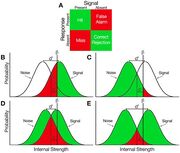Signal Detection Theory is a framework that accounts for the detection of a signal stimulus under conditions of uncertainty and is known for yielding measurements that meaningfully dissociate signal sensitivity from response bias. Sensitivity is indexed using the parameter d’ which takes into account the probabilities of hits and false alarms. Bias reflects the probability that an individual will produce one response (e.g., signal present) over the other (signal absent) and is assessed with C, which can be thought of as a decision criterion that shifts independently of sensitivity. Psychologists have applied the theory to research on perception, clinical diagnostics, decision making and memory.

Anderson, N.D. (03 June 2015). Teaching signal detection theory with pseudoscience. Frontiers in Psychology. https://doi.org/10.3389/fpsyg.2015.00762 (Retrieved from https://www.frontiersin.org/articles/10.3389/fpsyg.2015.00762/full)
Tanner, W. P., and Swets, J. A. (1954). A decision-making theory of visual detection. Psychol. Rev. 61, 401–409.